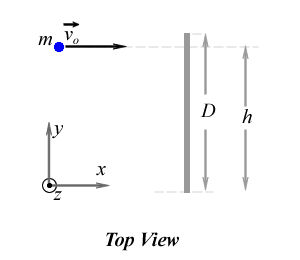A uniform bar of mass M and length d is initially at rest on a horizontal and frictionless table. A ball of mass m and very small radius is moving towards the bar with speed vo, hits and sticks to the bar at a distance h measured from on end of the bar. The bar is not attached to the table and its moment of inertia with respect to its center of mass is known to be Icm. The goal of the problem is to find the angular velocity and the velocity of the center of mass of the ball - bar system after the collision.

.
Solution:
Consider the system to be the ball and the bar. After the collision the ball-bar system will rotate about its center of mass as well as translate. The center of mass of the system is not at the middle of the bar but it ss a point between the ball and the bar's center of mass.
Modeling the objects:
Ball:
Because the ball has a small radius we will neglect any possible rotation of the ball an we will treat it as a point mass translating with initiall speed vo.
Bar:
We will treat the bar as a rigid body with its mass uniformly distributed therfore, its center of mass is in the middle of the bar.
Modeling the interactions:
Ball:
The ball interacts with the Earth, the surface and the bar. As a resullt of these three interactions there are three forces acting on it:
#The gravitational force exerted by the Earth on the ball, FEonBall.
#The contact force exerted by the ground on the ball. Because there is no friction this force has only one component perpendicular to the surface, FNonBall.
#The force exerted by the bar on the ball, FBar on Ball.
Bar:
The bar interacts with the Earth, the surface and the ball. As a resullt of these three interactions there are three forces acting on it:
#The gravitational force exerted by the Earth on the bar, FEonBar.
#The contact force exerted by the ground on the ball. Because there is no friction this force has only one component perpendicular to the surface, FNonBar.
#The force exerted by the bar on the ball, FBall on Bar.